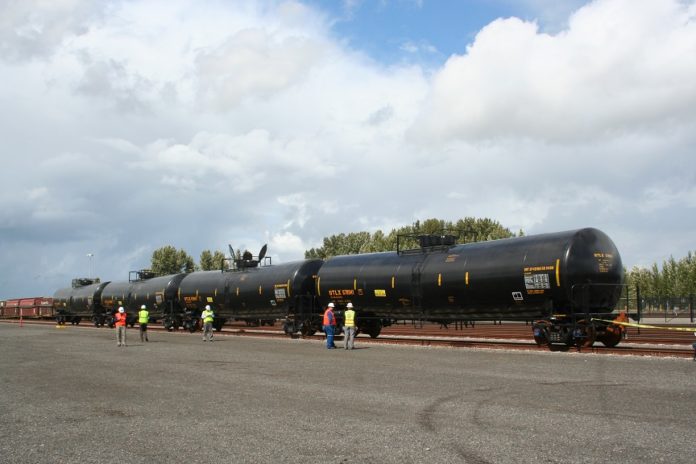This article has been updated to include statements from Vancouver Energy, Columbia Riverkeeper and the Port of Vancouver USA.
The Washington state Energy Facility Site Evaluation Council (EFSEC) has released its Draft Environmental Impact Statement (DEIS) regarding the proposed Vancouver Energy terminal at the Port of Vancouver.
Published online Tuesday morning, the DEIS describes the direct, indirect and cumulative environmental impacts that could occur from construction, operation and maintenance, and eventual decommissioning of the proposed facility, as well as from the transportation of crude oil to the proposed facility by rail and from the proposed facility to receiving refineries by vessel. This includes a variety of safety considerations and Bakken release scenarios.
Vancouver Energy, a joint venture between Tesoro Corporation and Savage Companies, is proposing to develop and operate a new 360,000 barrel-per-day crude-by-rail uploading and marine loading facility at the Port of Vancouver. The facility would serve as a transfer point for Bakken Crude Oil between North Dakota and West Coast refineries.
The release of the draft kicks off a 45-day public comment period. Comments can be made online at https://ts.efsec.wa.gov. Public feedback will be considered as EFSEC produces a final EIS, which is expected next year. That report will be sent to Governor Jay Inslee, who has the final say on the project.
In their own words
Following the release of the DEIS, a number of parties with ties and/or interest in the proposed project provided written statements to the Vancouver Business Journal. Here’s what they had to say:
Vancouver Energy
“We are pleased that EFSEC has released the draft EIS as this is an important milestone for the project and we look forward to entering the next stages of the permitting process. We are currently reviewing the document and will be able to address specific issues and respond to more detailed questions over the coming weeks.
Some helpful background on the purpose of the DEIS; as noted in the Executive Summary, “the purpose of the draft is to inform agencies, tribes, and the public about the environmental effects of the proposed Facility and the various measures identified by the Applicant, EFSEC staff, and EFSEC’s independent consultant to minimize those impacts, and to solicit input on that information during the public comment period. Input received during the comment period is used to revise the document and prepare the Final EIS.
At the same time the Draft EIS is developed, EFSEC may begin adjudicative proceedings. EFSEC’s adjudication is a formal hearing process similar to a courtroom trial. In the adjudication, EFSEC hears evidence presented by the parties to the adjudication, including the applicant, state agencies and local governments, and recognized intervenors such as tribes, interest groups, other local, state, or federal agencies, an assistant attorney general as counsel for the environment, and individuals with an interest not adequately represented by the other parties.
The Final EIS is used by EFSEC in conjunction with additional relevant information, including information gathered during the adjudication, to inform EFSEC’s recommendation and the governor’s final decision on an ASC. The information in the Final EIS can be used to condition the proposal to reduce impacts or to deny the proposal if significant adverse environmental impacts cannot be mitigated.”
Columbia Riverkeeper
Today, Nov. 24, 2015, the Tesoro-Savage Draft Environmental Impact Statement was released. The study demonstrates one thing: Tesoro’s oil trains and shipping terminal are too dangerous; too dangerous for Vancouver, for the Columbia (River) and for our climate. The combination of explosive oil trains, huge oil tanks on earthquake-prone ground and oil supertankers on the Columbia is reckless, and takes us in the wrong direction. The study released today gives Governor Inslee ample reasons to deny dirty oil and stand up for a clean and healthy Washington.
The Environmental Impact Statement finds:
- Safety: Workers and neighbors “could be at risk of injury or death” in the event of an explosion.
- Train traffic: “The additional four unit trains per day associated with the proposed Facility would increase [railroad crossing] gate downtime by between 15% and 26% along the [BNSF mainline along the Columbia River]. This increase in vehicle delays could constitute a major impact to emergency responders.”
- Earthquakes: “EFSEC’s independent seismic analysis confirmed that liquefaction was a concern given soil conditions underlying the proposed Facility site.”
- Salmon: “The increase in deep-draft vessel traffic associated with the proposed Facility could result in a moderate to major long-term effect on nearshore fish including listed salmonids and eulachon.”
Port of Vancouver
The DEIS documents EFSEC’s analysis of the Vancouver Energy project and provides an opportunity for stakeholders and the public to review and provide suggestions for improving the analysis.
The port has assembled a team of more than 20 staff members and consultants to review the DEIS and provide comments to EFSEC during the public comment period, which is Nov. 24, 2015, to Jan. 22, 2016.
“Vancouver Energy is a game-changing project with a complex DEIS,” said port CEO Todd Coleman. “As a key stakeholder in the project and community, it’s critical that we dedicate time and resources to a thorough review and provide comprehensive, constructive comments to EFSEC.”
Once submitted, the port’s comments will be available at www.portvanusa.com, as well as on the EFSEC website.










